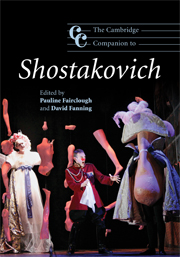Book contents
- Frontmatter
- Introduction
- PART I Instrumental works
- PART II Music for stage and screen
- 6 Shostakovich and the theatre
- 7 Shostakovich as opera composer
- 8 Shostakovich's ballets
- 9 Screen dramas: Shostakovich's cinema career
- PART III Vocal and choral works
- PART IV Performance, theory, reception
- Notes
- Select bibliography
- Index
7 - Shostakovich as opera composer
from PART II - Music for stage and screen
Published online by Cambridge University Press: 28 September 2011
- Frontmatter
- Introduction
- PART I Instrumental works
- PART II Music for stage and screen
- 6 Shostakovich and the theatre
- 7 Shostakovich as opera composer
- 8 Shostakovich's ballets
- 9 Screen dramas: Shostakovich's cinema career
- PART III Vocal and choral works
- PART IV Performance, theory, reception
- Notes
- Select bibliography
- Index
Summary
Shostakovich's musical genius was protean, but it was with opera above all that he wanted to consolidate the dazzling international reputation he established when Bruno Walter conducted his First Symphony in Berlin in February 1928. He was thus following in the footsteps of his nineteenth-century forebears Musorgsky, Tchaikovsky, Rimsky-Korsakov and Borodin, whose gravitation towards opera was a reflection of its central importance within Russian musical and cultural life. Somewhat surprisingly, opera continued to be a high-profile musical genre after the Revolution, despite its bourgeois associations, and new Soviet operas were actively sought for the main stages of Moscow and Leningrad, earmarked to become traditional symbols of national prestige as before. Shostakovich therefore had every reason to feel confident and optimistic when beginning his first opera in 1927.
After completing The Nose before he even turned twenty-two, Shostakovich embarked on what he planned to be a tetralogy of operas about women – a kind of self-styled Soviet Ring of the Nibelung. His Rheingold equivalent, The Lady Macbeth of Mtsensk District, was a huge success when it was first performed in 1934. Two years later, however, Shostakovich was stopped in his tracks by a savage denunciation of his new work in the Soviet Union's premier newspaper Pravda, following an infamous performance attended by Stalin. Quite apart from the fact that Lady Macbeth did not exemplify the principles of Socialist Realism, which had been launched in 1932 as the monolithic and conservative new style for Soviet artists to follow, this was the period marking the start of the ‘Great Terror’ – a time of mass arrests and summary executions.
- Type
- Chapter
- Information
- The Cambridge Companion to Shostakovich , pp. 179 - 197Publisher: Cambridge University PressPrint publication year: 2008
- 1
- Cited by



